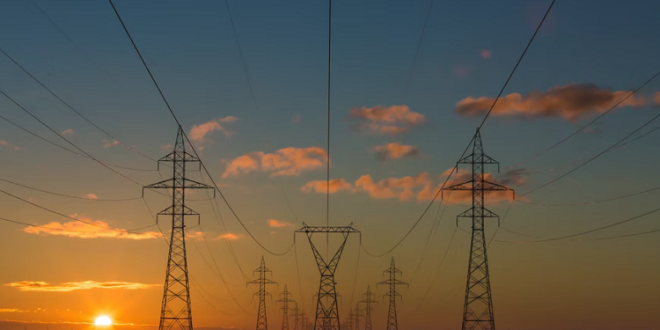Electric power distribution is a complex topic to understand. There are many different types of distribution, and each has its own set of challenges. In this blog post, we will explore how electric power is distributed from the power plant to your home or business!
Transformer
A transformer is a device that transfers electrical power from one circuit to another using electromagnetic induction. A schematic diagram of an ideal transformer, showing the primary coil at left transferring energy to the secondary coil on the right through magnetic coupling by way of near-field inductive electric fields. Transformers are often used in electricity distribution systems because they allow power transmission between circuits over mediums other than wires. There are two main types of transformers used for this purpose: pad-mounted and underground or pole-mounted transformers!
Pad-mounted transformers provide large quantities of voltage change with small physical dimensions for use in city streets where available space is limited. These can be found attached (pad-mounted) to buildings or poles next to roads, sidewalks, or other public places. Underground (pole-mounted) transformers are used in areas where high-voltage lines run underground to reduce visual impact and stay clear of street traffic! Underground distribution is typically the most cost-effective, but it does require more expertise when working on repairs.
Reclosers
Reclosers are devices that help regulate the flow of electric power on high voltage distribution systems. They can interrupt faults in both directions, re-energizing lines after a fault interrupts service to customers, or it can protect equipment from damage caused by overloads and short circuits. Recloser controls vary between manufacturers but they typically consist of an operating mechanism with external electromechanical contacts for controlling reclosing operations and a trip unit for opening the recloser upon detection of an overcurrent. Modern reclosers are fully automated and require minimal human interaction in most applications, resulting in lower labor costs.
Transformer Banks
Transformer banks are made up of multiple individual transformers which act together to help control power distribution. These can be either pad or pole mounted, and their purpose is to serve as a buffer between the lower voltage distribution system (which runs through your neighborhood), and the much higher transmission lines that carry energy long distances before it’s sent onto local substations for further delivery. This helps reduce the current flow on those long-distance wires because its reactive load counters what would otherwise cause an even greater drop in line voltages!
When there’s excess electric generation available from power plants, these transformer banks often help distribute some of this extra power out into nearby neighborhoods where demand may not be quite as high at certain times of day (like when everyone is at work). This helps keep the voltage up in the neighborhood which can help minimize power drops and fluctuations.
Another important function of transformer banks is to provide a constant source of reactive power during times where it’s needed most, like after faults occur on transmission lines! While faults are very rare (less than .0000001% chance per year), they do happen from time-to-time which require immediate attention. When there’s an outage due to this kind of fault, transformers along these long-distance wires automatically “trip” by opening their circuit breakers so that no more current flows through them until manual inspection and repairs have been completed or additional equipment switched in for service.
Voltage Regulation
As we covered earlier, voltage regulators help regulate the amount of power flowing through your neighborhood by using an adjustable reactive load. This helps minimize any significant drops in line voltages which can cause local blackouts and other problems if it’s not dealt with quickly enough! Voltage is also important for helping to keep appliances like air conditioners working properly during times when electricity demand is high (like on hot summer days). These devices rely on a stable source of electric current because this allows them to function optimally. If there’s too much fluctuation or drop-off over time, you’ll notice that they don’t work as well and eventually stop altogether until things return to normal again. This can be extremely frustrating if you’re trying to stay cool during a heatwave, but it’s simply how the electrical grid works!
Some people believe that having their local power plant can help avoid these kinds of problems because they generate electricity on-site. Unfortunately, this isn’t true since most plants have no control over what happens to their output once it leaves the facility and enters into your neighborhood’s electric distribution network. In other words, you’ll still experience voltage dropouts whenever there are faults or excess generation from distant sources as long as you’re connected to an external power grid! It doesn’t matter if those electrons came from wind turbines, solar panels, nuclear reactors, hydroelectric dams, geothermal wells, or anything else.
Power Factor Correction
Power factor correction is a topic that can get quite complicated, but it’s extremely important for helping reduce the amount of strain on power lines. As we learned earlier, reactive loads are very common in our modern society which means there will always be some degree of phase shift between voltage and current at any given time! This makes things more difficult for utilities because they have to generate enough extra power whenever needed (beyond what was already being consumed) so that this excess generation doesn’t cause overloading issues along the way. There are many different ways to address these kinds of problems—with capacitors or inductors being just one solution out of dozens available today. Capacitors help improve AC mains by “canceling out” the effect of inductive loads while inductors help improve power factor by “canceling out” the effects caused by capacitive loads.
These devices are highly effective for dealing with these kinds of problems, but they’re also very expensive and not always a feasible option in all cases where it’s needed. In some situations (like low-voltage distribution networks) power factor correction is unnecessary because there simply isn’t enough reactive load to make things difficult! These days most utilities use utility-interactive inverters which can quickly sense any imbalances or faults within your neighborhood grid at any given time—then automatically send commands back to local solar panels on homes/businesses so that they adjust their output whenever changes are required.
Power Quality Monitoring and Metering
As we covered earlier, voltage fluctuations or faults can cause local blackouts if they’re not corrected quickly enough. This is why it’s so important for utility companies to monitor power quality regularly as part of their routine maintenance activities. They use special equipment that continuously compares the mains supply against its standard operating values to catch any potential problems before they become more serious. In some cases, this might be done automatically by sending commands back down from central control rooms whenever there are issues detected at certain substations—while other times this will simply involve technicians going out onto the field with portable meters which allow them to measure things up close using handheld tools! These days smart grid technology has made many aspects of power quality monitoring much easier for utilities—and it’s also made the data they collect far more useful than in years past.
For example, there are now devices that allow utility companies to monitor voltage and current at any given point along with their distribution networks (or even on individual homes/businesses). This information can then be analyzed by special software which helps identify potential problems before they become serious enough to cause blackouts or other damage.
In conclusion, now you know how electric power is distributed! You can also see why having multiple sources for your home’s appliances helps keep things running smoothly.
 HammBurg Be informed with latest news, reviews, entertainment, lifestyle tips, and much more.
HammBurg Be informed with latest news, reviews, entertainment, lifestyle tips, and much more.




